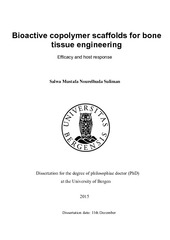| dc.contributor.author | Suliman, Salwa | en_US |
| dc.date.accessioned | 2016-04-15T09:07:55Z | |
| dc.date.available | 2016-04-15T09:07:55Z | |
| dc.date.issued | 2015-12-11 | |
| dc.identifier.isbn | 978-82-308-3435-0 | en_US |
| dc.identifier.uri | https://hdl.handle.net/1956/11916 | |
| dc.description.abstract | Current research focuses on developing a novel bone-inducing scaffold that could deliver controlled osteogenic growth factors. Several aspects, in particular those influencing the efficacy of such bioactive scaffolds, such as release kinetics of the growth factor, biocompatibility and biodegradability, need further study. The aim of this thesis was to determine a mode of bone morphogenetic protein-2 (BMP-2) delivery from copolymer scaffolds that reduce the dose to improve clinical safety while retaining efficacy. A low dose of 1 μg BMP-2 was immobilised via four different functionalising techniques on recently developed poly(LLA-co-CL) scaffolds. Sustained release of low levels was seen from BMP-2 physisorbed on nanodiamond modified scaffolds (nDP-PHY) for up to 70 days in vitro compared to that from scaffolds modified with microspheres containing BMP-2 (MICS) and unmodified scaffolds with physisorbed BMP-2 (PHY). No release was detected from BMP-2 covalently bound to nanodiamond modified scaffolds. nDP-PHY, MICS and PHY scaffolds promoted bone regeneration in a rat mandible critical-sized defect after 4 weeks, however, nDP-PHY and MICS scaffolds demonstrated osteogenic potential in vivo as well as in mesenchymal stem/stromal cell (MSC) cultures. Poly(LLA-co-CL) scaffolds modified with nanodiamond (nDP) and nDP with physisorbed BMP-2 were then evaluated through in vivo degradation, host tissue response and tumorigenic potential. Modified scaffolds degraded faster than unmodified scaffolds. Gene expression of proinflammatory, osteogenic and angiogenic markers were upregulated in the nDP and nDP-PHY scaffolds with ectopic bone seen at week 8 only from the latter. Inflammatory cells, foreign body giant cells and fibrous capsule tissue were significantly reduced around the modified scaffolds. Tissue regeneration markers were most highly expressed in the modified groups. Interestingly, nanodiamond particles were found in the implantation site after 27 weeks when 90% of the scaffolds had degraded. To evaluate the tumorigenic potential of the functionalised scaffolds in vivo, a sensitive and non-invasive model using xenotransplantation of early neoplastic oral keratinocytes transfected to express luciferase (DOKLuc) together with carcinoma associated fibroblasts (CAF) for monitoring microenvironmentally-induced carcinogenesis was developed. nDP scaffolds without BMP-2 reduced the bioluminescence intensity of positive control tumours formed by DOKLuc+CAF in vivo. When cultured in vitro as 3D organotypic models of neoplastic oral mucosa, DOKLuc previously cultured on nDP scaffolds demonstrated reduced tumorigenic potential compared to DOKLuc from nDP-PHY and unmodified scaffolds. nDP-PHY scaffolds showed enhanced tumorigenic potential in vivo and in vitro. These results suggest a role played by nanodiamonds in reducing tumorigenic potential of DOKLuc and also raises concerns for the therapeutic use of BMP-2 for the reconstruction of bone defects in oral cancer patients. This thesis also highlights that the mode of binding BMP-2 to a scaffold has a significant effect on its osteogenic potential. Furthermore, the efficacy of delivering low, sustained amounts of BMP-2 is emphasised and the modality of nDP-PHY is shown to provide a promising bioactive scaffold for bone tissue engineering. | en_US |
| dc.language.iso | eng | eng |
| dc.publisher | The University of Bergen | eng |
| dc.relation.haspart | Paper I: Suliman S, Xing Z, Wu X, Xue Y, Pedersen TO, Sun Y, Døskeland AP, Nickel J, Waag T, Lygre H, Finne-Wistrand A, Steinmüller-Nethl D, Krueger A, Mustafa K. Release and bioactivity of bone morphogenetic protein-2 are affected by scaffold binding techniques in vitro and in vivo. J Control Release. 2015;197:148–157. The article is available in BORA at: <a href="http://hdl.handle.net/1956/10184" target="blank">http://hdl.handle.net/1956/10184</a> | en_US |
| dc.relation.haspart | Paper II: Suliman S, Sun Y, Pedersen TO, Xue Y, Nickel J, Waag T, Finne-Wistrand A, Steinmüller-Nethl D, Krueger A, Costea DE, Mustafa K. In vivo host response and degradation of copolymer scaffolds functionalised with nanodiamonds and bone morphogenetic protein 2. Advanced Healthcare Materials 2016;5:730–742. This article is not available in BORA. The published version is available at: <a href="http://dx.doi.org/ 10.1002/adhm.201500723" target="blank"> 10.1002/adhm.201500723</a> | en_US |
| dc.relation.haspart | Paper III: Suliman S, Parajuli H, Sun Y, Johannessen AC, Finne–Wistrand A, McCormack E, Mustafa K, Costea DE. Establishment of a bioluminescence model for microenvironmentally induced oral carcinogenesis with implications for screening bioengineered scaffolds. Head and Neck. 2015 doi: 10.1002/hed.24187 (Epub ahead of print). The article is available in BORA at: <a href="http://hdl.handle.net/1956/11721" target="blank">http://hdl.handle.net/1956/11721</a> | en_US |
| dc.relation.haspart | Paper IV: Suliman S, Mustafa K, Krueger A, Steinmüller-Nethl D, Finne-Wistrand A, Osdal T, Hamza AO, Sun Y, Parajuli H, Waag T, Nickel J, Johannessen AC, McCormack E, Costea DE. Nanodiamond modified copolymer scaffolds decrease tumour progression of early neoplastic oral keratinocytes. Submitted Manuscript. This article is not available in BORA. | en_US |
| dc.title | Bioactive copolymer scaffolds for bone tissue engineering. Efficacy and host response | en_US |
| dc.type | Doctoral thesis | |
| dc.rights.holder | Copyright the author. All rights reserved. | |
